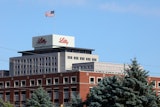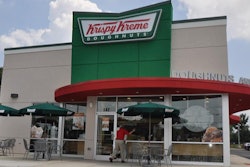GE’s Brilliant lighting plant in Hendersonville, NC was almost shuttered less than decade ago. Now it’s one of the company’s top facilities. Here's how it happened.
Western North Carolina is essentially a hipster’s paradise. The city of Asheville alone has 26 craft breweries — giving it the most per capita in 2017 according to Forbes magazine — while three national forests and rolling Appalachian hills throughout the topography give it a picturesque outdoor scene.
But traditionally, the region is home to a rich history of manufacturing that remains strong today. General Electric has two GE Aviation Plants in the area — Asheville and West Jefferson — with the Asheville plant home to the world’s largest jet engine.
Thirty miles south of Asheville, just outside Hendersonville, NC, resides a GE Brilliant Lighting factory, where the company produces its commercial outdoor lighting products under the “Current, Powered by GE” division. Coming out of the Great Recession, the factory was almost shut down. At the time, the company rated it in the lower half of its nearly 500 plants globally.
Today, GE rates the same Hendersonville plant among its top 10.
I recently visited that GE plant, where its state-of-the-art equipment and cutting edge lean operations made it hard to believe the location faced closure less than a decade ago. I was able to learn the story of its revitalization, what it has going on currently and where it’s headed.
Setting The Stage
The roots of GE’s lighting division — headquartered in East Cleveland, OH — can be traced back to Thomas Edison’s work in the late 1800s. The Hendersonville plant opened in 1955 and has been lighting America’s infrastructure and cities ever since, making outdoor lighting products that include fixtures for roadways and commercial property and downtown decorative fixtures.
A walk around GE’s Hendersonville facilities today leads one to think of the factory’s past. Most of the campus’ original buildings don’t look much different from the outside than 60-plus years ago other than some faded paint here and there. Old street lamp products populate green spaces between facilities, including a spotlight near the edge of the property that has seen better days. Still standing next to the plant is its “Crossroads of Light” — a street intersection lined with various lighting products made to showcase to customers throughout the factory’s first three decades.
Those were roaring times for the Hendersonville factory. But by the time the end of the 2008-2009 recession, a major drop in sales and outdated production operations had the plant facing closure. Employee layoffs and extended time off put GE at a make-or-break situation in Hendersonville.
“It was definitely on the slate,” says David Martin, who has been with GE since 1998 and the Hendersonville plant manager since 2014. “It was after the financial meltdown and orders had dropped severely.”
So, GE sent an outside consultant to the plant to observe its operations over several months.
“He was tasked with the question of, ‘Is Hendersonville the right place to continue making outdoor fixtures, and if so, is there anything that needs to be changed?” says David George, who has been with GE at the Hendersonville plant for 18 years and currently serves as manufacturing engineering manager. “His answer back was, ‘It is the right place, and everything needs to change.’”
So, What Changed?
Once it was determined the plant was still viable, the management team started down the journey of figuring out how to make those changes and to see them through. George became GE’s Hendersonville business transformation leader in 2011 as part of a three-person team tasked with changing the factory’s internally-focused operations to focus instead on the customer.
Historically, the plant did business on a six- to eight-week lead time timeframe, with a roughly 60 percent on-time shipping rate. In a nutshell, speeding up that timeframe was the crux of the transformation. George’s team collaborated with GE’s outdoor lighting sales staff to create a roadmap for increased efficiency.
“We wanted to get it to two weeks or less, and 95 percent on-time,” George says. “That became the driving goal: ‘how do we take where we are and get there?’”
According to George, the simple answer was a three-part formula: you need a customer order; you need to know which of GE’s millions of SKUs to build and how many; and you need the material on-hand. The team moved forward with that framework and built it out. At a very high level, it’s still how the plant runs today.
On a granular level, the team overhauled three areas of the plant’s manufacturing operations — order processing, materials and production — and shortened the overall cycle.
With order processing, GE streamlined who needed to be involved, making the customer order flow a straight line instead of getting held up in different departments. Exceptions to the straight-line process were treated as true exceptions instead of as the rule. Instead of arbitrary order scheduling, the plant installed a first-in, first-out queue.
On the material side, the plant adopted a supermarket concept for the floor layout, making it so that all material enters the plant on the north end and leaves on the south end. When material comes in, it is inspected and then sorted into the appropriate “supermarket” aisle on the north end, with items sorted by commodity.
On the production side, the plant began using “mini-markets” — assembly subsets of the supermarket that only have the parts needed for a particular product line. A bin system cut down on transactions in material requirements planning (MRP). The plant’s new customer-centric assembly process was based on order size instead of overall volume.
“We changed from, ‘how efficient were you today?’ to on-time ship hits and misses,” George says. “It ended up being a far more beneficial metric than we every realized because every last employee can relate to the importance of shipping on time.”
When it came to small orders — as small as single-digit orders — the plant made small work cells where an employee assembles the entire light fixture from start-to-finish, instead of the traditional assembly line processes where one employee handles one assembly task at a time. So if the plant receives an order for three lighting fixtures, the same employee is going to assemble all three entirely, test them and get them shipped. Meanwhile, large orders are handled by a more traditional assembly line. But a key change was orders of all sizes were given equal priority, served simultaneously.
Martin elaborated how the Hendersonville plant was operating in a traditional batch-oriented manufacturing process, using MRP. For a vertically integrated manufacturer, MRP works well because the facility makes its own products and can react to fast changes. But when that manufacturer starts offloading processes to vendors and not making it in-house anymore, demand becomes scattered and leads to various inefficiencies. Martin and George shared that before implementing these wholesale changes, the plant was struggling to hit even 60 percent on-time shipping.
“You’re setting yourself up for disaster,” Martin says about how that sequence progressed at the plant. “So a few things cracked the code. One was the length of time getting an order from the customer to the shop floor, with the help of some automation and letting 85 percent of the orders flow directly through electronically without anybody touching them. That was a game-changer. The other was ‘who cares about MRP?’ Instead, be that supermarket that has all the parts needed for the level of business you’re expecting. It won’t be perfect, but you’re not waiting for an order before you go get the parts for it. In theory, you’ve already got them in stock.”
George shared other improvements made alongside the plant’s three-pronged changes to a customer-focused operation. One was the elimination of more than 40 lift trucks from the plant floor, which increased employee safety. Another was moving all raised inventory down to the first level. The plant changed from pneumatic tools to DC tools, which increased ergonomic usability for employees.
“We completely revamped everything we did,” George says. “That’s part of what all the money’s spent on — just being better at all of it as we touched every area.”
Next up was enhancing the plant’s digitization. GE’s manufacturing IT team digitized the paper packets that each order includes, showing product drawings and building material. The team developed a new manufacturing execution system — MES 1.0 — followed by adding on-demand printing for product labels and increasing the use of barcoding.
Overall, these changes happened between 2011 and 2014, but the plant has continued to improve on them ever since. In the process, Hendersonville quickly moved up GE’s factory reputation scale into “Brilliant” status, a category reserved for the company’s showcase facilities based on their level of digital infrastructure. As of the end of 2017, Hendersonville is one of nine GE Brilliant factories.
A Boost From LED
With all that operational and digital infrastructure in place by 2014, Hendersonville was in prime position to receive a consumer boost from the market shift to LED lighting. In 2013, only 18 percent of the plant’s overall production volume was for LED lamps, compared to 82 percent for HID lamps. That LED portion rapidly grew to 48 percent in 2015; 74 percent in 2016; 83 percent in 2017; and 89 percent through the first quarter of 2018.
Since 2014, GE has invested more than $40 million in Hendersonville as LED sales ramped up — adding a new production area for the manufacture of LED circuit boards. Until then, those boards were outsourced to overseas vendors, with some boards taking up to eight weeks to arrive at Hendersonville. The plant’s new, high-tech equipment instead is able to churn out those boards in 15 minutes or less, ensuring that they end up in fixtures — and ultimately with customers — much faster.
The Plant Today
The Hendersonville plant continues to invest in technology and digital tools to increase its capabilities and efficiencies. The plant is now onto MES 2.0, powered by GE Intelligent Platforms, which utilizes performance analytics, product line integration, lean tempo and genealogy to drive insights and operational improvements. In 2017, two major Lean projects resulted in significant productivity improvement. One involved transforming the plant’s SMT Make to Customer Order process, slashing its total inventory — of which more than half was considered dead — by 85 percent and increasing inventory turnovers from three to four per day to 15 to 20 per day. The other project was for the plant’s in-house direct orders and resulted in reducing work-in-progress time from eight days to one and reducing obsolete exposure by 88 percent.
“We finally decided to take the plunge and go make-to-order on our components,” Martin says. “I think that has probably been our biggest improvement in the last couple of years, for sure.”
Another recent development was the addition of digital boards to all of the assembly lines that show stats including the name and location of the customer and that line’s production goal and current pace. Other monitors within arms’ reach of any assembly employee allow them to call directly to maintenance instead of first having to contact several managers.
The plant has also increased its usage of collaborative robots. In 2015, Rethink Robotics picked the Hendersonville plant to install its “Sawyer” to aide in repetitive assembly tasks. The plant began by staging material for Sawyer to place three different parts inside a light fixture. But creating work for the robot defeated its purpose of automation. So, Sawyer was reassigned to handing off glass used on street lamps to human workers, and most recently put on a new application in which three Sawyers interact with one Silicon dispensing robot in a material presentation role.
On The Horizon
Current is transforming its business further in Hendersonville, leveraging sensors and the Internet of Things to help enable intelligent environments — smart cities and smart buildings. It’s the latest step in the continuous evolution from a light bulb company to a lighting solutions company.
In November 2017, GE announced its intention to sell its Lighting division and Current by GE as it looks to focus on three core business areas: aviation, power and healthcare. At the time, GE said it has no plans for any changes to the plant as it pursues a sale, which was still ongoing as of mid-June.
“Over the past two years, Current has generated significant growth in delivering new energy efficiency and digital productivity outcomes for its customers,” the company said in a November statement. “GE’s goal is to find a buyer that can help Current continue progressing on its growth journey.”
Regardless of the future ownership, the plant’s recent revitalization and ongoing journey toward continuous improvement has it well equipped for the future.
All plant photos by IMPO























